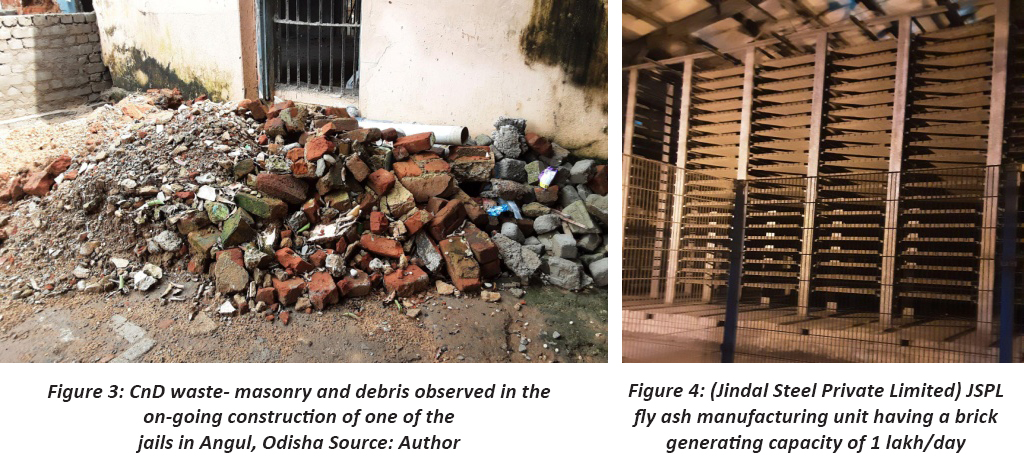|
Potential for Circular
Economy in Infrastructure
The
The traditional clay brick sector in India accounts for 5.5% of total greenhouse gas (GHG) emissions and depletes approximately 500 million tonnes of cultivable topsoil. In the end-of-life stage of buildings, 716 million tonnes of C&D waste is being generated across the country annually. Hence, there is an urgent need to foster a rethinking systems approach for integrating circular economy principles across various sectors for green, equitable and inclusive growth. To address the same, the district administration of Angul in Odisha came up with an ambitious ‘Vision-2023’ plan in February 2021. The objective is to create a sustainable model making Angul self-reliant in its economy and natural ecosystem. Angul is a highly industrialised district that provides 15% of India’s coal and 5% of the country’s steel in addition to 5,000 MW power supply, which is the overall generation from the district. Besides, Angul is highly forested with 42% land in the district under forest cover and 30% being used for agriculture. This makes it a resource-rich district with high potential to explore the angle of circular economy across these sectors. During one of the field visits to Angul, the Development Alternatives team observed that on-going construction and demolition works in local infrastructure development projects such as jails, schools and health centres generated a huge amount of C&D waste, such as concrete, iron rods, wood and masonry waste, which holds tremendous potential to be recycled and reused in ongoing construction projects. During the visit to industrial power plants located at Kaniha and Talcher, it was observed that about 3,000-20,000 metric tonne of fly ash is generated every day which is being utilised for making various products such as lightweight aggregate (LWA) which is highly durable and greater in strength than the normal aggregate. They are also producing paver blocks for internal infrastructure development and nearby villages that fall under their CSR projects. Fly ash is the by-product of thermal power plants that results from the combustion of pulverised coal and is transported from the combustion chamber by exhaust gases. Fly ash utilisation has significant environmental benefits such as reduction in GHG emissions, effective substitution of red bricks and in the construction of highways. The Odisha MSME Development Policy of 2016 mandates the usage of fly ash bricks (FAB). The team observed that for the construction of new jails and schools in Angul, FAB was being used instead of red bricks. As per the MOEFCC 2020 guidelines, National Aluminium Company Limited (NALCO) is providing incentives, supplying fly ash to SMEs brick-producing units and to National Highway Authority (NHA) for making roads and highways. National Thermal Power Corporation’s (NTPC) research wing is also carrying out final testing on conversion of fly ash to sand in collaboration with NTPC Energy Technology Research Alliance (NETRA), New Delhi. It was observed that in the industrial power plants, the process of aluminium- and steel-making generated waste such as slag, sludge and metal craps. Industrial waste is defined as waste generated by industrial processes which has a huge scope to be reused and recycled resulting in a cleaner production of services. For example, granulated sludge can potentially be used to prepare sand with higher resistive qualities than natural sand which may reduce harmful sand mining practices. Industries are also supplying blast furnace slag to cement producing companies in Karnataka as an effective additive in the cement manufacturing process.
Angul district currently has low scores on human development parameters and is prone to climate change due to imbalance in the consumption of natural resources. The bright side is that being a resource-rich, industrial district, it generates appropriate revenues to take decisive action. Hence, it is important that stakeholders such as government authorities, NGOs and line departments come together on a common platform through the creation of institutional mechanisms such as agile sustainable procurement policies using tools such as circular economy dashboards and adopting frameworks for improved data-based decision-making such as PEST (Political, Economic, Social and Technological) analysis and LCA (life cycle assessment) to evaluate the environmental burdens associated with materials used and wastes released to the environment for robust data-based decision making.■ References:
Rashi Sirohi |
 concept
of Circular Economy aims for restorative, regenerative, recycled,
reusable and inventive design. It reduces the dependency on natural
resources by encouraging the use of secondary resources such as
plastics, industrial waste, construction and demolition (C&D) waste for
production, thereby promoting efficient use of resources, addressing the
global resource scarcity and climate change. Moreover, massive
quantities of critical resources are extracted for production of
building materials.
concept
of Circular Economy aims for restorative, regenerative, recycled,
reusable and inventive design. It reduces the dependency on natural
resources by encouraging the use of secondary resources such as
plastics, industrial waste, construction and demolition (C&D) waste for
production, thereby promoting efficient use of resources, addressing the
global resource scarcity and climate change. Moreover, massive
quantities of critical resources are extracted for production of
building materials.
